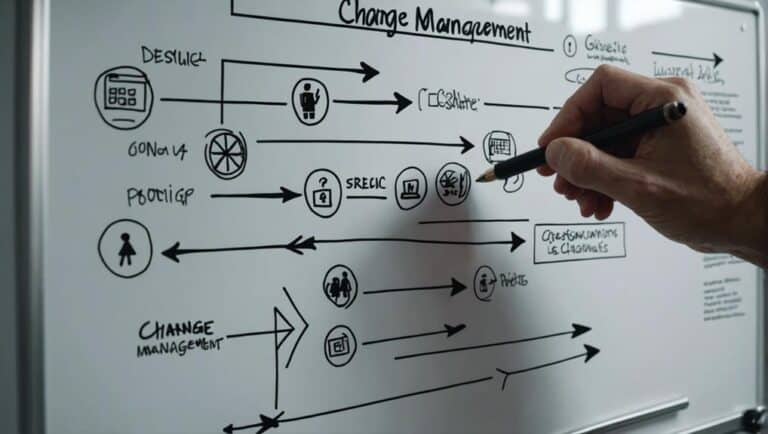Considering that change is the only constant in this ever-evolving world, every company must have robust change strategies in place. One of the most critical processes in change management is documenting all the changes and their impacts. But how can you effectively document your change management?
You can document your change management by keeping a running record of the process of the change you are implementing. This record includes a list of files with objectives, your process for change management, and your analyses. It would be best if you used visuals frequently in your documentation.
This article includes a step-by-step guide to effectively documenting your change management. With this guide, you can create a detailed review of the change management you’re implementing and reflect on its successes and failures.
1. Include Objectives
The first part of your change management document should outline clear objectives and a rationale for why you are introducing the changes. This should ideally be a bullet-pointed list that presents a clear need for change.
Some of the common reasons that companies introduce a change include:
- Developing skills. Human resource changes like introducing a trainer are made to improve an employee’s skills. Ultimately, this boosts staff morale and employee output.
- Improving production or output. Companies frequently introduce changes to improve the output of employees or the production of a product. While the primary reason is improving production, these changes can also improve staff pay and the available facilities.
- Boosting staff morale. Some changes are introduced to improve staff’s engagement with the company. These may be different work hours or changes to the kind of deliverables employers require.
- Scaling the organization. Many changes are introduced to help an organization grow. These changes can include introducing new resources or a new software system that makes it easier to carry out processes.
Use these reasons as guidelines for writing out your objectives.
2. Assess Where the Company Currently Sits
To track change, it is vital to recognize where the company was when you started the change process. By doing this, you have an unbiased source you can refer back to after the change to see how effective it has been.
To communicate where the company currently sits in a particular area, you should include qualitative and quantitative data.
Quantitative data may include statistics about production or employee size and capacity.
Qualitative data includes descriptions of how an area in the company currently operates.

3. Assess the Organization’s Change Management Readiness
Before beginning to roll out your change management plan, you should conduct surveys that assess your company’s scope for change. A leader or manager should only try to implement a few changes at a time, so they don’t dilute the effects.
Here are some things to consider when assessing your organization’s readiness for change:
- Knowledge. Ensure your organization’s leaders and managers have the proper knowledge and information to navigate the change.
- Desire. It’s hard to teach or motivate a team that doesn’t have the desire for change. Make sure your team is ready for change by sharing the benefits of the proposed change.
- Ability. You should consider their ability even if your team has the knowledge or desire to see through a particular change. Try to understand what skills the change may involve and then train your team in these skills.
4. Create a Change Management Process and Procedures
All successful companies use Standard Operating Procedures or SOPs to carry out operations. You should make sure you have a robust change management process that outlines the actions and timelines of the changes.
Here’s what you should include in your change process:
- Goals. Similar to objectives, goals clearly explain what a company or individual is trying to achieve through the proposed change.
- Key Performance Indicators. Just as you would with an individual, outline what Key Performance Indicators you expect the change to show. Make sure you also have a plan of how you will track these Key Performance Indicators.
- Communication plan. The change process should include a communication plan and timeline for the changes that will be carried out. The communication plan will also include the method of communication – one type may be via email, while another may be through a meeting or staff gathering.
- Plan for resistance management. Every kind of change will meet some form of resistance. Your change process should include some ideas of how you will respond to this resistance.
- Implementation plan and timeline. It is best not to introduce a wide variety of changes all in one go. Instead, have an implementation plan allowing employees and the company time to get used to one change before introducing another.
- Training plan. The process should also outline how you are going to train each employee. Providing this to each employee affected by the change will reassure them that it will not negatively affect their output.
The change process document should form a significant part of the change management document. As you are carrying out the change, you should also add a reflection to each section of your change management process document.
5. Create Clear Quantitative and Qualitative Metrics
To assess the effectiveness of a change management process in a company, you need to have established clear metrics. These metrics highlight milestones you are trying to reach through introducing the change. Milestones can be described either quantitatively or qualitatively.
Quantitative milestones include specific numerical deliverables you are trying to achieve. For instance, a company introducing a change to improve website traffic may set an increased number of website hits as a milestone.
Meanwhile, qualitative milestones may include descriptions of a type of culture your company is trying to achieve. For instance, a new training program may list increased motivation and better outputs as part of the qualitative milestones.
Your change management document should have the qualitative and quantitative milestones under easy-to-discern sections.

6. Use Visual Documentation
You should use visual documentation in all forms throughout your whole change management document. Visual documentation helps a reader understand the process and outcomes of change. Different types of visuals can be most powerful in different parts of your change management document.
Here are some visual documents you may consider using:
- Flowcharts. Flowcharts can be a highly effective form of communication. They can explain and break down extremely complex information, like a process or the outcomes of a particular change.
- Infographics. Infographics are a great way to highlight the critical data you find during the change process. They are also a great way to highlight the benefits of a particular change to employees.
- Videos. Videos are a great way to improve engagement and understanding of a particular change. You may want to use a video of your company’s leaders introducing and briefly discussing the change. You may also include a video where employees provide feedback and reflections on the change.
7. Get Continuous Feedback
Your change management document should include the feedback you gather from employees and other stakeholders in the change. The document should include positive and negative feedback to present a holistic overview of the change.
Here are some ways you can gather feedback from all parties involved with the change:
- One-on-one discussions/interviews. While implementing change, continuously ask the stakeholders for verbal feedback. This can be in casual discussions or more structured panel interviews.
- Surveys and feedback forms. Collect both named and anonymous surveys to assess how your company responds to change. Anonymous surveys can be helpful in identifying the kind of struggles that employees are facing with the change. Meanwhile, named surveys can help you support particular employees or get specific individuals on board with the change.
- Personal reflections. If you play an integral part in instilling a change, you should continuously reflect on the process of implementing the change. Try to do this reflection through audio notes and written reflections. This allows you to improve your change management skills. While doing a personal reflection, focus on both your professional actions as well as your personal attitudes toward a particular challenge.
Include all your feedback and corrective actions in your change management document.

8. Include Easy-To-Interpret Data and Analyses
Through the change management process, you should gather data on the impact of the change. It’s helpful to look at the outcomes and milestones you have strategized to understand the data you have to gather.
Include all the raw data you have gathered in your change management document. This may include tables, percentages, and qualitative data. You should also include your processed data in the change management document – this may be in graphs, pie charts, or other data processing diagrams.
9. Make the Documentation Available to Your Team
When engaged in change management, you should try to be as transparent as possible. Make the change management document available to your team for input and review. Sharing the document with your team can also help them adopt a holistic approach to the change.
When making the document live, protect all contributing individuals’ confidentiality. Either get their written permission to publish the document or change the names on the document to protect their identity.

10. Summarize the Outcomes of the Change
Once you reach the end of the change implementation process, review the outcomes, measuring them against the metrics. You should include a summary of the measurable outcomes resulting from the change. This is a great time to conduct a quick evaluation of how the process held up in comparison to your expectations.
11. Create a Brief Abstract of the Document
All research papers have an abstract that summarizes the paper’s scope, rationale, and findings. You should use the same approach to a change management document. Here’s what to include in your change management abstract:
- A rationale. Talk about the reasons you wanted to implement the change.
- The process. Briefly summarize the steps that were used in implementing the change.
- The stakeholders. Include an overview of all the individuals involved in the change. This can include employees, leaders and managers, customers, and associated companies.
- The outcomes. Briefly describe the outcomes you saw as a result of the change. Map these outcomes against the outcomes you proposed at the beginning of the change.
- A reflection and improvements. In your reflection, you should include how you would change and improve a similar change management process.
12. Use the Correct Vocabulary
When you’re documenting the changes you are making and managing them, you should continuously remind yourself of the purpose of the document you are creating. You should ensure the document is written in accessible language so third parties can easily understand it.
Some ways that you can make the language easily accessible include:
- Having a glossary of terms. If you are introducing unfamiliar or subject-specific words into your change management document, including a glossary of terms is helpful in the glossary, including information about the word you have used and the contexts in which it is used.
- Using footnotes. Adding footnotes to a complex term will help readers immediately understand what it means.
- Getting the document reviewed. Once you have completed the document, get it reviewed by someone unfamiliar with your changes. They can suggest edits that make the document easier to read.
Making sure you use the correct vocabulary and language will help ensure that the document stands the test of time.
13. Back Up Your Documentation
While you create your change management document, you should ensure it is backed up on various systems and platforms. Making sure the document is backed up protects your data and learnings from being lost. The best way to go about this is to keep both digital and hard copies of all essential documents.
14. Look for Templates
If it’s one of the first times you’re implementing change, talk to your managers or leaders for guidance on how best to document the changes. Each organization has a different approach; some may use spreadsheets, while others use online project management tools.
You can look for templates online if your organization doesn’t have a template. These templates provide a helpful structure and considerations you should review while documenting the change.
What Are the Key Elements to Effectively Document Change Management?
When it comes to revolutionizing change management reporting, it is crucial to focus on key elements such as clear communication, stakeholder engagement, detailed documentation of changes, and regular monitoring and evaluation. These elements ensure that the change process is effectively documented and communicated throughout the organization.
Final Thoughts
Effectively documenting your change management can help ensure that you have a holistic record of the kind of adjustments that you implement. This document can help you assess the benefits of a change and reflect on the improvements you can make to your change management process.
Sources





